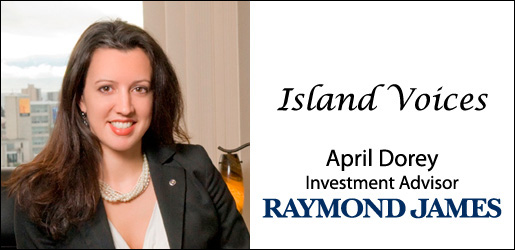Current Article ∙ Archive ∙ Back to Island Voices
Investment Outlook
Investors worldwide rushed away from risk earlier this week in the wake of Japan’s tsunami and nuclear disaster, with Tokyo’s benchmark NIKKEI 225 Index plunging 11% after being down as much as 14% during the day. The human toll in Japan is tragic and still unfolding. In addition, there is unquestionably going to be an impact on the Japanese economy, the world’s third largest, which was already on unsteady footing. However, while the full extent of that impact will not be known for quite some time, it’s difficult to believe that Japanese companies as a whole were worth 11% less on Tuesday than they were on Monday.
Investors inevitably react to catastrophic events by seeking safe havens for their assets, a response that caused prices for U.S. Treasuries, European government bonds, Swiss francs and other traditional places of refuge to rise on Tuesday. This immediate response, while certainly understandable, is rarely the best long-term course of action for investors.
It’s important, particularly at times like this, to distinguish between price and value. The price of any given stock is what someone is willing to pay for it at the moment an investor chooses to sell. The value to the investor represented by his or her fractional ownership of the company issuing the stock is something entirely different, and reflects not the mood of the moment but the long-term worth of the company. Although stock prices swing to the upside and to the downside in response to events, over time they follow the values of the companies they represent. These values very rarely change overnight.
As we head into the second quarter of 2011, a carefully considered investment strategy is more important than ever. If you’re feeling nervous about your investments or you’d like to review whether your savings are optimally positioned to meet your objectives, I’d be pleased to assist you with that. Just give me a call.
Investment Idea
With four of Japan’s nuclear sites down (and likely to stay down) due to the earthquake and subsequent tsunami, the country has to replace roughly 1.6 billion cubic feet per day (Bcf/d) of energy demand. The country has several options as fuel for power generation: oil, coal, and liquified natural gas (LNG). The earthquake damaged at least two refineries and some other fuelburning plants, meaning that oil power generation will be slightly limited. This means that LNG could supply roughly 50% of the incremental demand, or 780 million cubic feet per day. This does NOT appear to be a significant problem for Japan for several reasons: (1) Asian buyers have offered to divert cargoes to Japan on a swap basis (i.e., Japan “borrows” the gas and returns it at a future date, (2) suppliers all around the world have stepped up to offer any incremental cargoes for Japan, and (3) Qatar likely has the capability to supply the incremental LNG to Japan (while maintaining current high volumes to the U.K.) now that it has all of its trains (that are used to transport 10 billion cubic feet per day) up and running.
Canadian dollar idea
GasFrac Energy Services (symbol GFS March 18, 2011 closing price CAD $12.30/share) provides pressure pumping of liquified petroleum gas fracturing services to oil & gas companies in Canada and the US. Pressure pumping has historically been one of the more cyclical sectors within the oilfield. When activity strengthens and industry capacity becomes constrained, it quickly leads to sharply higher utilization, pricing, and margins. This prompts significant investment in new pumping capacity. Since it is not that hard to add pumping capacity, pressure pumpers ultimately add enough capacity to bring margins (and pricing) down sufficiently to discourage the newbuild process. If this is coupled with an unexpected drilling slowdown (as in 2008), then it could be a disaster for those service companies levered to pressure pumping. However, we believe that the market is missing the impact of higher equipment attrition rates. How long would your grandmother’s Cadillac last if Dale Earnhardt Jr. took it for a couple hundred laps around Talladega without a pit stop? That is what the industry is doing to pressure pumping equipment today.
We believe equipment attrition rates are set to explode (no pun intended) in 2011 and 2012. This is the single biggest factor the market is not talking about. J. Marshall Adkins, Director of Energy Research and Managing Director of Equity Research Raymond James & Associates expects annual attrition rates to climb from the mid-single digits to 20+% by 2012, which could equate to over two million horsepower per year being removed from the market. Oil service companies tend to generate higher revenue for fracturing services in Canada than the US further benefitting GasFrac Energy Services.
Please contact me if you would like a copy of our latest research on the company or sector.
US dollar idea
Royal Dutch Shell (symbol RDS.B March 18, 2011 closing price US $69.78/share, dividend yield 4.1%) Shell has invested billions of dollars in their joint venture Quatargas 4 project and their Pearl GTL (gas to liquids) project and the company expects to produce more natural gas than oil from 2012 onwards. Natural gas is the cleanest-burning fossil fuel emitting 50-70% less carbon dioxide (CO2) than coal when burnt to generate electricity. Here is a summary of some of Shell’s major projects:
- Athabasca Oil Sands Project The Athabasca Oil Sands Project (AOSP) extracts bitumen from oil sands and converts it to synthetic crude oil.
- Sakhalin II One of the world’s largest integrated, export oriented oil and gas projects.
- Shell Eastern Petrochemicals Complex (SEPC) Meeting Asia’s growing demand for petrochemicals.
- Port Arthur Refinery Expanding to become one of the largest US refineries.
- Pearl GTL Building the world’s largest plant converting natural gas into clean-burning liquid transportation fuel and other high-value products.
- Qatargas 4 is Shell’s first entry into Qatars liquefied natural gas (LNG) sector.
April M. Dorey, B.Comm, FMA, FCSI
T: 250-405-2429 or 1-888-778-0356
april.dorey@raymondjames.ca
www.aprildorey.com
*Please note, changes in tax laws may occur at any time and could have a substantial impact upon each person’s situation. You should discuss any tax or legal matters with the appropriate professional. Written by April Dorey and expresses the opinions of the author and not necessarily those of Raymond James Ltd. Statistics and factual data and other information in this newsletter are from sources RJL believes to be reliable but their accuracy cannot be guaranteed. Securities-related products and services are offered through Raymond James Ltd., member CIPF. Financial planning and insurance products and services are offered through Raymond James Financial Planning Ltd., which is not a member CIPF. In accordance with privacy legislation, the individuals you are referring must consent to their information being provided to me.
© April Dorey. Articles, statistics and other data referred to or cited are intended to provide readers with potentially useful information for their own personal use. *Please note, changes in tax laws may occur at any time and could have a substantial impact upon each person’s situation. You should discuss any tax or legal matters with the appropriate professional. Reproduction without permission is permitted with due acknowledgement. The views expressed are those of the author, April M. Dorey, and not necessarily those of Raymond James Ltd. It is provided as a general source of information only and should not be considered to be personal investment advice or a solicitation to buy or sell securities. Investors considering any investment should consult with their Investment Advisor to ensure that it is suitable for the investor’s circumstances and risk tolerance before making any investment decision. The information contained in this article was obtained from sources believed to be reliable, however, we cannot represent that it is accurate or complete. Raymond James Ltd. is a member of the Canadian Investor Protection Fund.

